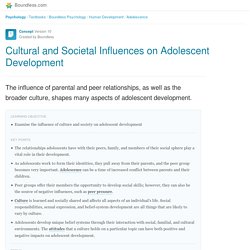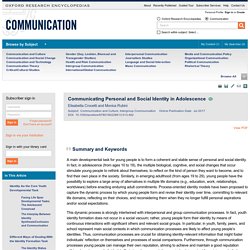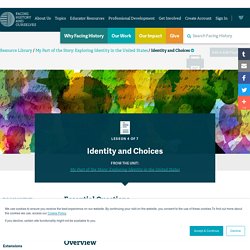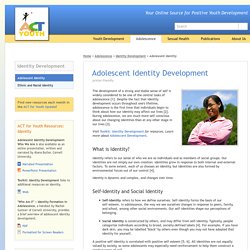

Cultural and Societal Influences on Adolescent Development (Teacher or Family Read) The relationships adolescents have with their peers, family, and members of their social sphere play a vital role in their development.

Adolescence is a crucial period in social development, as adolescents can be easily swayed by their close relationships. Research shows there are four main types of relationships that influence an adolescent: parents, peers, community, and society. When children go through puberty in the United States, there is often a significant increase in parent-child conflict and a decrease in cohesive familial bonding. Arguments often concern new issues of control, such as curfew, acceptable clothing, and the right to privacy. Communicating Personal and Social Identity in Adolescence - Oxford Research Encyclopedia of Communication (Teacher Read)
Abraham, K.

G. (1983). The relation between identity status and locus of control among rural high school students. Journal of Early Adolescence, 3, 257–264.Find this resource: Arnett, J. J. (2000). Identity and Choices Lesson Plan. The last two lessons of this unit demonstrated how outside factors such as names, labels, and assumptions can influence identity.

One goal of this lesson is to help students become more self-aware and realize that they have the opportunity to make choices about who they are. Sometimes the choices a person makes, consciously or unconsciously, can affect how others perceive that person. Students will consider how choices—like deciding what to wear in the morning, how to style themselves, or how to present themselves on social media—can emphasize some aspects of their identities while minimizing or hiding others.
Sometimes others react to us based on choices we make, and the reactions of others can affect our future choices. This feedback loop can be observed perhaps most plainly in the ways that we create and revise our identities online. Discovering My Identity Lesson Plan.
Erik Erikson’s Identity Crisis: Who am I? Adolescent identity resource. Identity and bi-cultural development. ACT for Youth - Adolescence - Adolescent Identity Development. The development of a strong and stable sense of self is widely considered to be one of the central tasks of adolescence [1].

Despite the fact that identity development occurs throughout one's lifetime, adolescence is the first time that individuals begin to think about how our identity may affect our lives [2]. During adolescence, we are much more self-conscious about our changing identities than at any other stage in our lives [3].